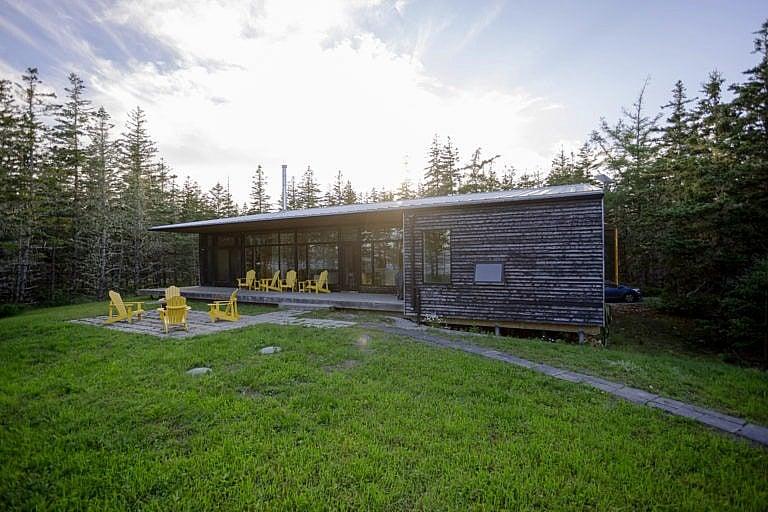Habitat: This sustainable Nova Scotia home is a coastal refuge
“It came to us perfect. We’ve grown so attached to it that we never want to leave.”

Share

Teri Appleby and Nova Tayona met in 1995 while waitressing together as students at Dalhousie University. In late 2012, they caught up over coffee in Halifax. Tayona was an architect, and Appleby was a homemaker and mother of two sons. While they chatted, Appleby happened to describe the cottage she’d been dreaming about for her family. She wanted a summer escape from her century-old home in downtown Halifax, with direct access to water and an open-concept main floor.
She and her husband, Keith Dwyer, had already toured the South Shore of Nova Scotia in search of the perfect property, but none of the cottages for sale appealed to them: the lots were too small and the buildings too run down. So they switched gears. After months scouring for vacant beachside land, the family finally bought a nearly four-acre property shrouded in tamarack and spruce trees in Shelburne County, two hours southwest of Halifax. Located barely 100 metres from the Atlantic shoreline, the lot peered over the secluded Louis Head Beach and a kilometre-long stretch of white sand.
The only thing left to do was build a home. Tayona, who specialized in contemporary architecture and loved working on coastal projects, decided her friend’s story sounded like a great challenge. “If you’re up for it,” Tayona said, “I want to make this idea come to life for you.”

The design and construction process took more than three years; heavy snowfall in the winter months made it impossible to drive to the site, which sat a mile away from the nearest paved road. Given the limited supply of labour in Shelburne, there were only a few people ever available to work on the house at a time. In 2017, Appleby and Tayona’s vision finally came to life as a 1,500-square-foot modern summer cottage with a cantilevered roof, perched on raised helical piles to avoid flooding. The front view features floor-to-ceiling windows and a black cedar façade. Inside, 12-foot Douglas fir ceilings tower over locally crafted birch cabinets and polished concrete floors. The 550-square-foot chef’s kitchen has already hosted countless family dinners.
READ: Habitat: A mid-century sanctuary by Ontario’s Chandos Lake
Despite its remote location, the house has gained fame for its sustainability, winning a Canadian Green Building award in 2017. The roof is strategically positioned to provide shade for the interior during intense midday sun; it also captures rainwater, which funnels into three large cisterns with a capacity of 12,000 gallons each, and then through a UV filter to make it drinkable.
On the north side of the cottage, there are three bedrooms with impressive views of the surrounding forest and a guest room with a 12-foot cedar door. The primary bedroom is sequestered on the other side of the house. “We thought we might want to make the cottage a rental for part of the time, and just lock away all of our belongings in the primary room,” says Appleby. “But we’ve grown so attached to it that we never want to leave.”

The family has lived in the cottage from May to September every year since 2017. Parting ways with the convenience of the city comes with challenges: the nearest grocery store is a half-hour’s drive away, which forces them to buy in bulk and plan meals ahead of time. They bring as much food as they can from their visits to Halifax, and when they crave fresh produce, they travel an hour to their favourite farmer’s market in Bridgewater. The Wi-Fi is also unreliable, so they use Starlink satellite internet for a faster connection. Appleby says those minor lifestyle shifts are well worth the serenity: she has never encountered more than 15 people at the Louis Head Beach at once—and that includes her own family.
RELATED: Habitat: A former New York Times journalist built this beachside fortress in P.E.I.
The home has quickly become an extended-family hub. The couple’s parents, who all live an hour away, come for frequent visits, while their brothers, sisters and friends, many of whom are in and around Halifax, often join them for weekend get-togethers. Those days are filled with late-afternoon low-tide strolls on the beach, boisterous family meals and explosive intergenerational game nights.

“The house came to us perfect,” says Appleby. “There is truly nothing like having a morning coffee on the deck under the roof—you can feel the sun’s warmth on your face.” This year’s summer routine was as dreamy as ever: daily trips to the beach with her boys, now 15 and 18, and family nights making s’mores over a bonfire.